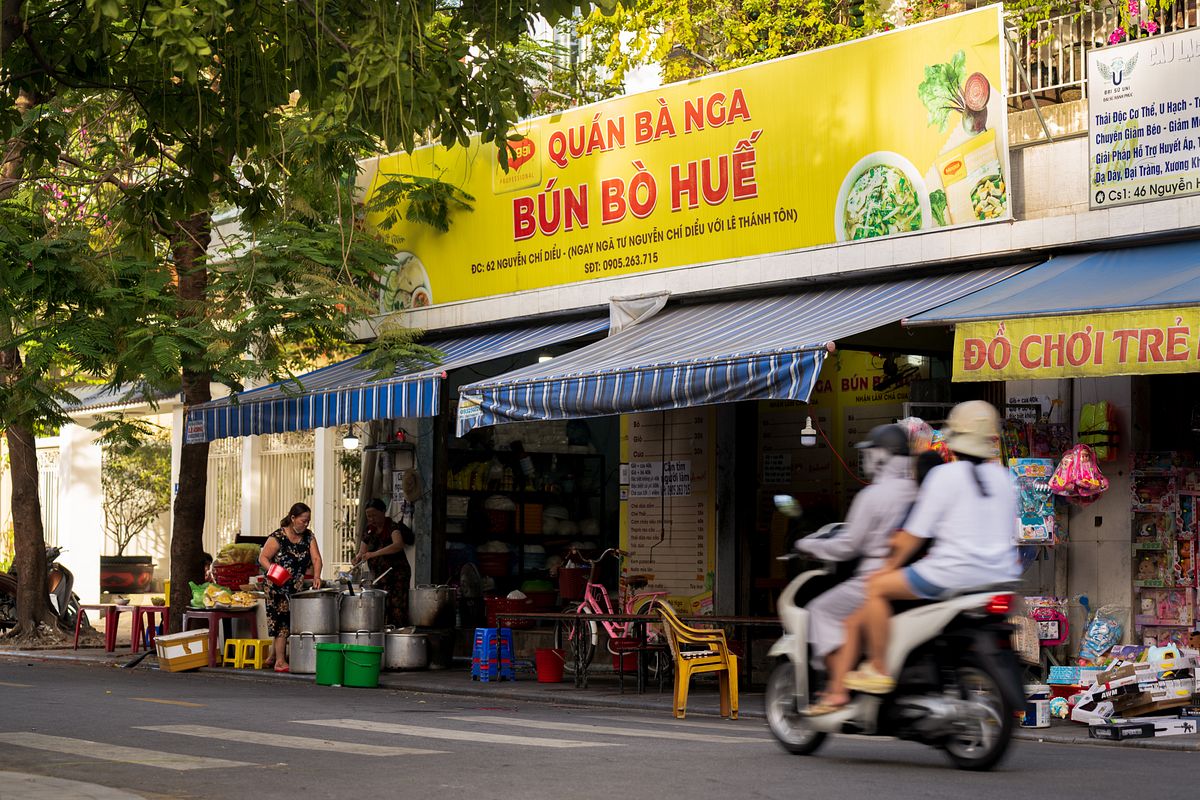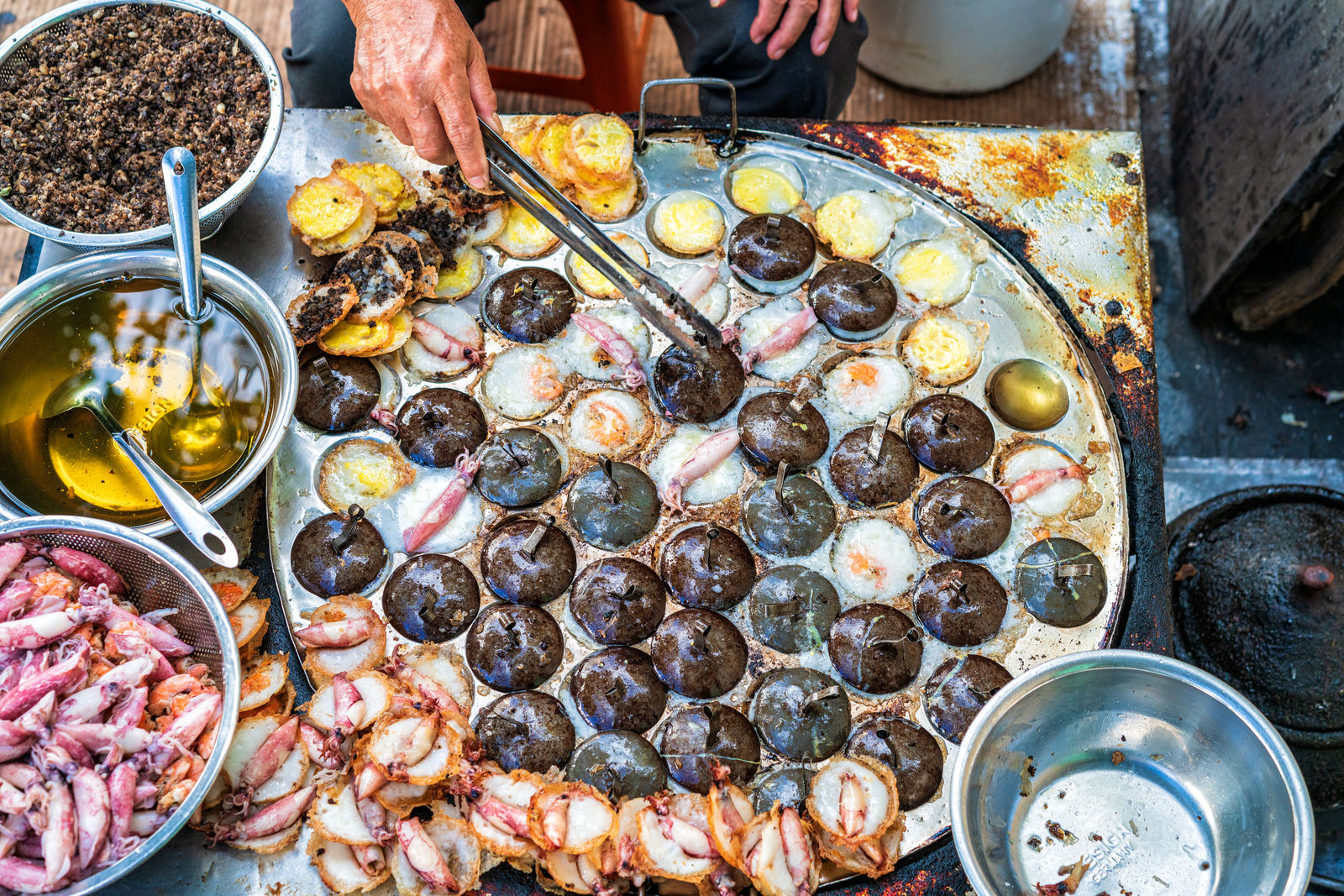Plastic stools circling low metal tables. Staff wearing pajamas and street clothes that match patrons welcomed from all walks of life. Meagre and/or mismatched decor. Views of street traffic with motorbike engines as soundtrack. Brief menus sometimes consisting of a single dish. A strict cash-only policy (until recent years, at least). Minimal concern for health-safety regulations. No artifice of chef as artist or meal as a masterpiece. While we can quibble over a specific, all-encompassing definition for streetfood restaurant, there are many qualities most will agree they share.
At first glance, Quán Bà Nga in Huế is a quintessential street food restaurant. Sutured into an inconspicuous neighborhood less than 1 kilometer from the Imperial Citadel’s West Gate, it contains not only near-platonic ideals of street food conventions but the best bowl of bún bò Huế I’ve ever had. While increasingly known amongst out-of-towners, it remains a favorite spot for the locals who keep it crowded from 3pm until late.
Thin gold bracelets encircle the arm that stirs a steaming vat of broth and meat. Beside her, other employees shuffle around a preparation table disheveled by stacked bowls and waiting ingredients: noodles, chives, lettuce, pork legs, and blood sausage. Beyond them, a few food delivery drivers wait next to a vendor taking advantage of the crowd to sell fresh jackfruit. Passing them leads to the wondrously unpretentious dining room where pots, pans, plastic baskets, and surplus sugar cane rest on rickety shelves against bare, waterstained walls.


Crumpled napkins litter the floor along with spent limes, their dry flesh reminding one of a cicada's desiccated shell. You won’t be greeted, but if you find an empty table, someone will notice you and come by to relay your request to the women beside the pot. Speed is another tenet of street food restaurants. Rarely does one wait more than a few minutes for their food to arrive, and the entire dining experience can often be completed in less time than it takes for an average Ferris wheel rotation.
If your visit to Quán Bà Nga is anything like mine, however, you might experience a thrill before you begin eating. I went alone on a random weeknight. Frequently accompanied by my Kindle, I enjoy dining out alone. This time, however, I was not alone. I was joined by a child. A few moments after I’d sat down and ordered, and hardly a few stanzas into my book, a man who appeared to be in a rush pushed a boy of ten years old or so to the empty plastic chair across from me. After depositing him in his place and ordering something from the staff, he shuffled out the door and sped off down the road. He hadn’t so much as made eye contact with me, let alone attempted an explanation of why his son would be my dinner companion. Made no difference to me, as I quickly returned to my reading and the boy quietly slurped the noodles that soon were set in front of him. A quiet and unstressed acquiescence to the hectic happenstance of life is a hallmark of a street food restaurant.
For me, bún bò Huế in general is a mid-tier noodle soup. And before you begin crafting hate messages, let me clarify that I rank it as such because Vietnam is blessed with many wonderful noodle soups and I am actively committed to upholding the reputation of “mid” as an adjective meaning average, which is in no way a bad thing. Not everything has to be extremely, utterly, stupefyingly wondrous to be worthwhile and enjoyable: it's dinner, not a search for salvation. But when I express to friends that I think bún bò Huế is merely a mediocre noodle dish, by Vietnamese standards, I am frequently told I must be going to the wrong places. I should go to its city of origin to appreciate it. Thus, on a recent trip to Huế, I followed the recommendation of Saigoneer staff who told me to visit Bà Nga.


Another element of street food is the absence of written recipes or standardization, allowing for daily and regional variations. No two shops prepare identical dishes, and the differences become more significant the further apart they are (a smarter person than I could probably illustrate this fact with a coefficient-laden, variable-rich equation). This is certainly true for bún bò. Each stereotypical difference between bún bò in Saigon and bún bò in Huế is seemingly subtle but becomes significant in aggregate. The bún in the south is thicker while chả lụa takes the place of crab cakes and pork blood. Southern broth renditions typically rely on beef bones and beef balls for flavor while the broth in Huế takes a more pork-centric approach thanks to pig bones and knuckles. The central broth is also more aromatic and spicy while the southern take is more subdued and single-note sweet from added rock sugar. Finally, locally available and seasonally specific herbs and vegetables alter the overall flavor and texture. It’s impossible to attribute the holistic experience to a single difference, but bún bò in Huế strikes me as a more complex and cohesive dish wherein the elements elevate one another rather than vying against one another for prominence.

In addition to the taste, another significant difference between bún bò in Huế and Saigon is the price. Simply, like most things, it's much cheaper in Huế. A fully loaded đặc biệt bowl with beef, crab and pork knuckle will only set you back VND40,000–50,000 at Bà Nga, while a dish with only one protein is just VND30,000. And given the heat from the chilis and overwhelming summer humidity, a refreshing nước mía for VND5,000 is the easiest decision you’re liable to make all day.
The more one travels throughout the world, the more likely one is to cherish Vietnam’s street food restaurants. Many of the qualities Bà Nga exemplifies get lost amidst modernization’s demands for standardization and regulation. A certain indescribable flavor is imparted into a dish when enjoyed on a plastic stool in a humid, noisy, dirty room so stuffed with convenience, tradition, and serendipity it threatens to burst into chaos at any moment.
It’s certainly the ideal environment to enjoy one of the country’s most beloved dishes. And dear reader, it shouldn’t matter to you one bit if Quán Bà Nga affected the placement of bún bò Huế on my personal Vietnamese noodle power rankings. You should make your own decisions, but I will recommend you experience it here to understand its full potential.
To sum up:
- Opening time: 5am–11pm
- Parking: In front of the restaurant (bike only)
- Contact: 0905263715
- Average cost per person: $ (Under VND100,000)
- Payment: Cash, Transfer
- Delivery App: ShopeeFood
Paul Christiansen only writes and edits because he can't afford a durian farm, yet. Read more at his website.
Quán Bà Nga
62 Lê Thánh Tôn, Phú Hậu, Huế


















